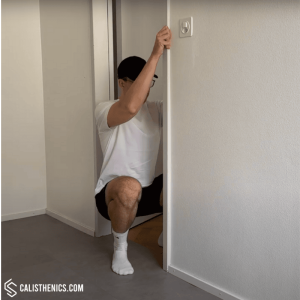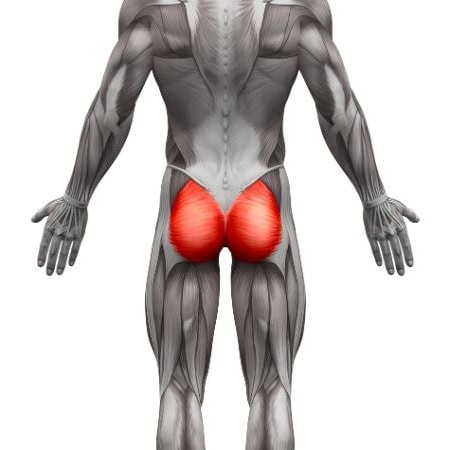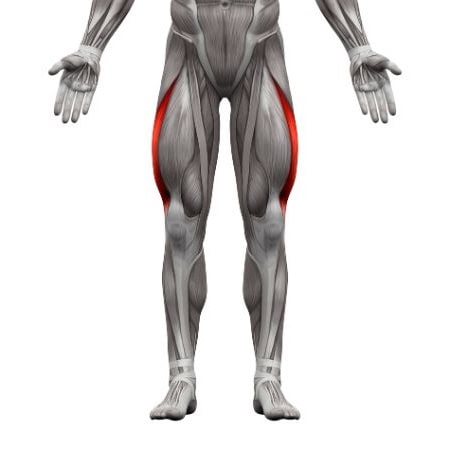Doorframe Squats
How to do Doorframe Squats?
Doorframe squats are a variation of the traditional squat, where the athlete holds onto a doorframe for balance and support. By gripping the sides of the doorframe, this exercise allows for improved stability, making it easier to focus on proper squat form. It’s especially useful for beginners, individuals with mobility issues, or those recovering from injuries, as it reduces the pressure on the knees and back while still engaging the lower body muscles. Doorframe squats are an excellent way to strengthen the legs and glutes while improving balance and posture.
Steps to Perform a Proper Doorframe Squat:
1. Set Up at the Doorframe:
• Stand in front of an open doorway with your feet about shoulder-width apart and your toes pointing slightly outward.
• Grab the edges of the doorframe with both hands, using your fingers to hold onto the protruding edges. Your arms should be straight, and your hands should be positioned at about chest or waist height for support.
2. Engage Your Core and Prepare to Squat:
• Tighten your core to maintain stability and posture throughout the movement. Keep your chest lifted, shoulders back, and spine neutral.
• Your weight should be evenly distributed across your feet, with a slight emphasis on your heels.
3. Lower into the Squat:
• Inhale as you slowly begin to lower your body by pushing your hips back and bending your knees. Keep your chest lifted and maintain a firm grip on the doorframe for balance.
• Focus on sitting back as if you’re sitting into a chair. Lower yourself until your thighs are parallel to the ground or as low as your flexibility allows.
• Keep your knees aligned with your toes, avoiding letting them cave inward.
4. Push Back to Standing:
• Exhale as you press through your heels to stand back up, using the doorframe for assistance if needed. Focus on using your legs to lift your body while maintaining a neutral spine and upright posture.
• Return to the starting position with control, avoiding any jerky movements.
5. Repeat:
• Perform the desired number of repetitions, ensuring that you maintain proper form and controlled movement throughout.
Benefits of Doorframe Squats
• Improves Squat Form: By holding onto the doorframe, this exercise allows you to focus on proper squat mechanics, making it easier to develop correct form for more advanced squat variations.
• Enhances Balance and Stability: The doorframe provides support, helping beginners or individuals with balance issues perform squats more safely and confidently.
• Strengthens the Lower Body: Doorframe squats engage the quadriceps, glutes, and hamstrings, helping to build strength and endurance in the legs.
• Improves Mobility and Flexibility: Regular practice of doorframe squats can help improve hip, knee, and ankle mobility, making it easier to perform deeper squats over time.
• Gentle on the Knees and Lower Back: The support provided by the doorframe reduces the load on the knees and lower back, making this variation ideal for individuals recovering from injury or those with joint issues.
• Functional Strength Development: Squats mimic everyday movements like sitting and standing, making them essential for developing functional strength that improves daily activities and athletic performance.
• Accessible for All Fitness Levels: Whether you’re a beginner, recovering from injury, or looking for a low-impact squat variation, doorframe squats offer a scalable way to build strength and mobility in the lower body.
Common Mistakes to Avoid
• Relying Too Much on the Doorframe: While the doorframe provides support, focus on using your legs to perform the squat. Relying too heavily on the doorframe reduces the effectiveness of the exercise.
• Letting the Knees Cave Inward: Ensure your knees track over your toes and do not collapse inward during the squat. This protects your knees and engages the correct muscles.
• Leaning Forward: Keep your chest lifted and your back straight. Avoid leaning too far forward, which can place unnecessary strain on your lower back.
• Rushing the Movement: Perform the squat slowly and with control, especially on the descent. Rushing through the movement can lead to improper form and reduce the effectiveness of the exercise.
Tips for the proper execution of Doorframe Squats
Core Engagement: Keep your core tight throughout the movement to support your lower back and maintain good posture.
Knee Alignment: Ensure your knees track in line with your toes during the squat. Avoid allowing your knees to collapse inward, which can place strain on the joints.
Use the Doorframe for Balance, Not for Lifting: While the doorframe provides support, focus on using your legs to perform the squat. The doorframe should be used primarily for balance, not to pull yourself up.
Keep Your Weight in Your Heels: Press through your heels as you stand up, engaging your glutes and hamstrings. This helps protect your knees and ensures proper muscle activation.
Breathing: Inhale as you lower your body into the squat, and exhale as you stand back up. Controlled breathing helps maintain focus and control during the movement.
Muscles worked when doing Doorframe Squats
Primary Muscles:
•Quadriceps: The front of the thigh is heavily engaged during the squat, especially as you lower your body and push back up.
•Glutes: Gluteus maximus and medius (engaged to push your hips back and drive through the heels during the ascent).
•Hamstrings: Assist in stabilizing and controlling the descent, while engaging during the standing phase.
Secondary Muscles:
•Core: Abdominal muscles work to stabilize the torso and maintain balance throughout the movement.
•Lower Back: Erector spinae muscles help maintain posture and support the spine during the squat.
•Calves: Engaged to help stabilize the lower legs and provide balance during the squat.
•Hip Flexors: Assist in the bending of the hips and knees during the descent.
Primary Muscle(s):
Secondary Muscle(s):

Lower back
Equipment needed for Doorframe Squats
No equipment needed for this exercise.
Adjust the difficulty of Doorframe Squats
How to make Doorframe Squats harder?
How to make Doorframe Squats easier?
How to make Doorframe Squats harder?
To make Doorframe Squats harder:
-
Reduce Reliance on the Doorframe: Lighten your grip on the doorframe and use it only for balance, allowing your legs to perform the majority of the work. This helps build greater leg strength and stability.
-
Add Weight: Wear a weighted vest to increase resistance and challenge your lower body muscles further.
-
Increase Repetitions or Sets: Perform more repetitions or sets to build endurance and strength.
-
Slow Down the Tempo: Lower your body slowly (3-5 seconds) to increase time under tension, further challenging your quadriceps, hamstrings, and glutes.
How to make Doorframe Squats easier?
To make Doorframe Squats easier:
-
Reduce the Depth: If you’re just starting out or have limited mobility, lower your body only partway into the squat. Gradually increase your depth as you become more comfortable with the movement.
-
Increase Hand Support: Hold onto the doorframe more firmly, using it to assist with balance and pulling yourself up slightly during the ascent.
-
Perform Fewer Reps: Start with a smaller number of repetitions (5-8) and gradually increase as your strength and endurance improve.




